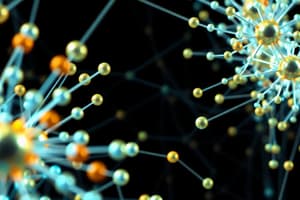Podcast
Questions and Answers
¿Cuál es el propósito principal del proceso de validación de modelos?
¿Cuál es el propósito principal del proceso de validación de modelos?
- Analizar la sensibilidad del modelo a los cambios en los parámetros
- Comprobar si el modelo es precisa y confiable (correct)
- Identificar los suposiciones y estructuras del modelo
- Ajustar los parámetros del modelo para que se ajusten a los datos del mundo real
¿Cuál es el tipo de validación que se centra en verificar si el modelo se ajusta a los datos del mundo real?
¿Cuál es el tipo de validación que se centra en verificar si el modelo se ajusta a los datos del mundo real?
- Validación interna
- Validación facial
- Análisis de sensibilidad
- Validación externa (correct)
¿Qué es el proceso de calibración de modelos?
¿Qué es el proceso de calibración de modelos?
- Un proceso de verificación de la precisión del modelo
- Un proceso de identificación de los suposiciones del modelo
- Un proceso de análisis de la sensibilidad del modelo
- Un proceso de ajuste de parámetros del modelo para que se ajusten a los datos del mundo real (correct)
¿Qué tipo de software de simulación se utiliza para modelar sistemas dinámicos?
¿Qué tipo de software de simulación se utiliza para modelar sistemas dinámicos?
¿Cuál es el método de calibración de modelos que utiliza algoritmos de optimización para encontrar los parámetros que mejor se ajustan?
¿Cuál es el método de calibración de modelos que utiliza algoritmos de optimización para encontrar los parámetros que mejor se ajustan?
¿Cuál es el propósito principal de la validación de resultados en modelado por simulación?
¿Cuál es el propósito principal de la validación de resultados en modelado por simulación?
¿Cuál es una característica importante a considerar al seleccionar software de simulación?
¿Cuál es una característica importante a considerar al seleccionar software de simulación?
¿Qué tipo de análisis de sensibilidad implica variar varios parámetros al mismo tiempo?
¿Qué tipo de análisis de sensibilidad implica variar varios parámetros al mismo tiempo?
¿Qué componentes clave componen un modelo de dinámica de sistemas?
¿Qué componentes clave componen un modelo de dinámica de sistemas?
¿Qué prueba estadística se utiliza comúnmente para determinar si la salida de un modelo es una buena aproximación a un conjunto de datos observados?
¿Qué prueba estadística se utiliza comúnmente para determinar si la salida de un modelo es una buena aproximación a un conjunto de datos observados?
Study Notes
Model Validation
- The process of determining whether a simulation model is accurate and reliable
- Involves comparing the model's output with real-world data or experimental results
- Types of validation:
- Face validation: checks if the model's assumptions and structure are reasonable
- Internal validation: checks if the model's internal logic is correct
- External validation: checks if the model's output matches real-world data
Model Calibration
- The process of adjusting a model's parameters to match real-world data or experimental results
- Involves finding the best-fit parameters that minimize the difference between the model's output and the real-world data
- Calibration methods:
- Manual calibration: trial-and-error approach
- Automatic calibration: uses optimization algorithms to find the best-fit parameters
Simulation Software
- Types of simulation software:
- Discrete-event simulation software (e.g. Arena, Simio)
- System dynamics simulation software (e.g. Stella, Vensim)
- Monte Carlo simulation software (e.g. MATLAB, Python)
- Features to consider when selecting simulation software:
- Ease of use
- Flexibility and customization
- Performance and scalability
- Integration with other tools and software
System Dynamics
- A method for modeling and analyzing complex systems with feedback loops and nonlinear relationships
- Key components:
- Stocks (accumulations of resources)
- Flows (rates of change of stocks)
- Feedback loops (positive and negative loops that affect the system's behavior)
- System dynamics is used to study complex systems, such as population growth, resource depletion, and supply chains
Sensitivity Analysis
- A method for analyzing how changes in a model's parameters affect its output
- Types of sensitivity analysis:
- One-at-a-time (OAT) analysis: varies one parameter at a time
- Multi-parameter analysis: varies multiple parameters simultaneously
- Global sensitivity analysis: uses statistical methods to analyze the sensitivity of multiple parameters
Chi-Squared Goodness of Fit Test
- A statistical test used to determine whether a model's output is a good fit to a set of observed data
- The test calculates the chi-squared statistic and compares it to a critical value or uses a p-value to determine the significance of the fit
- The chi-squared test is commonly used in simulation modeling to validate the model's output
Calculating the Optimal Number of Simulations
- The number of simulations required to achieve a desired level of accuracy and confidence
- Factors to consider:
- Desired level of precision
- Model complexity
- Computational resources
- Methods for calculating the optimal number of simulations:
- Replication analysis
- Confidence interval analysis
Calculating the Number of Runs or Replicas
- The number of times a simulation is run to achieve a desired level of accuracy and confidence
- Factors to consider:
- Desired level of precision
- Model complexity
- Computational resources
- Methods for calculating the number of runs or replicas:
- Replication analysis
- Confidence interval analysis
Validation of Results
- The process of ensuring that the simulation results are accurate and reliable
- Involves checking the results for:
- Consistency with the model's assumptions
- Reasonableness of the output values
- Robustness to changes in the model's parameters
- Methods for validating results:
- Visual inspection of the output data
- Statistical analysis of the output data
- Comparison with real-world data or experimental results
Studying That Suits You
Use AI to generate personalized quizzes and flashcards to suit your learning preferences.
Description
Test your knowledge of simulation modeling concepts, including model validation, calibration, software, system dynamics, sensitivity analysis, and more.




